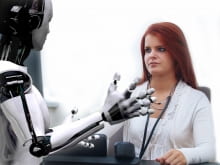By: Cathy Liu
Advancements in automation in the workplace have created opportunities for increased collaboration between humans and machines. A recent article on Axios about human trust towards robots emphasized the importance of “calibrating a human’s trust to a machine’s capability.” Humans must find the right balance with how much trust they place in machines. In multiple sectors from healthcare to manufacturing, human supervision and interaction with machines have become the norm as automation becomes more and more prevalent. But these increased interactions have also begged the questions: how much do humans trust machines and how can we measure this trust accurately?
A paper published by a team of researchers from Purdue University (Akash, Hu, Jain, & Reid, 2018) on sensing human trust in machines explores the psychophysiological features that indicate how humans perceive intelligent system. A subsequent goal of the study was to build a trust sensor model to train machines to adjust their behavior according to the subject’s perception. Two types of trust, situational and learned, can be changed through short interactions, and greatly depend either on a given circumstance or previous experience, respectively. In the study, participants engaged in a computer-based simulation where they drove a car with a sensor that could detect obstacles on the road. Participants were able to see whether or not the sensor detected an obstacle and then were prompted to choose to trust or distrust the machine. The participant was then provided with feedback about the correctness of their decision. The researchers used an EEG (electroencephalogram) and a measure of galvanic skin response to capture participants’ physiological activity in response to altered performance of the machine. The results of the study showed that the body tends to change in a specific pattern in response to increased trust in a machine in real-time. By using and improving these models in the future, it is possible that machines will be able to adjust their behaviors based on human psychophysiological response. This would increase the trust between humans and machines and allow for effortless interactions that increase the efficiency of work.

